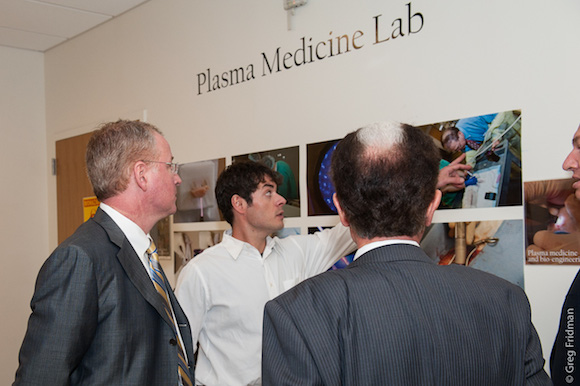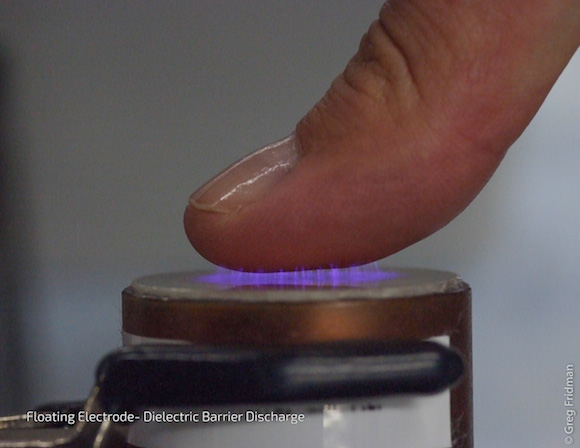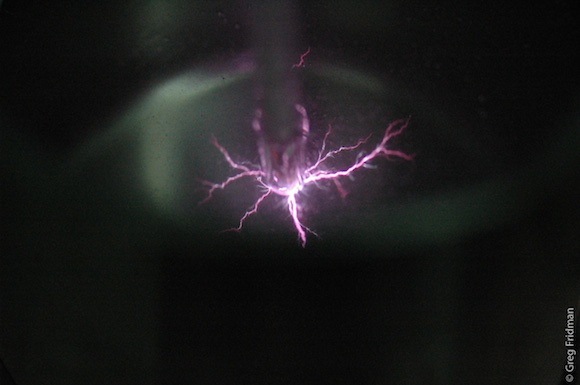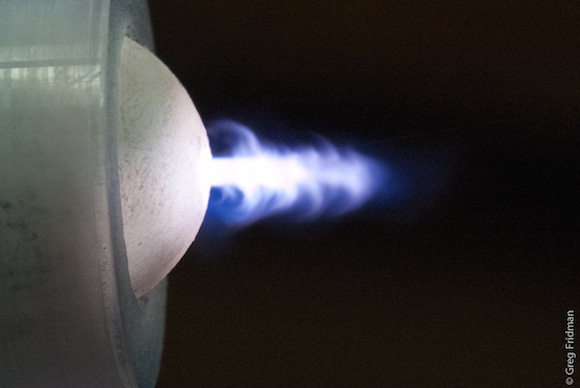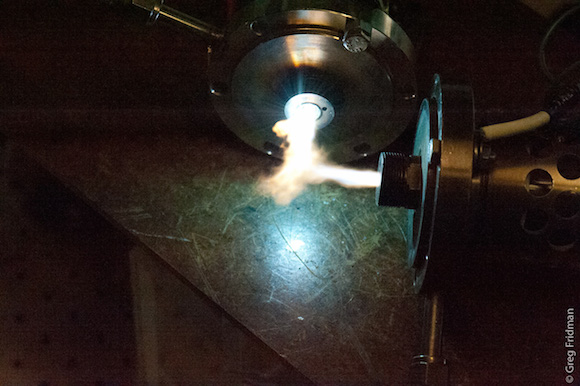You may not be aware of it, but plasma could change your life.
Since 2002, scientists at the A. J. Drexel Plasma Institute (DPI), a division of Drexel University located in Camden, N.J., have been working on finding applications for plasma technology in the fields of medicine, energy and the environment.
Now, with close to 100 patents focused on everything from cleaning water to helping the body fight cancer, they are ready to enable others — including Advanced Plasma Solutions (APS), a Pennsylvania company founded explicitly for commercialization of these technologies — develop products based on their ideas.
There's nothing new about plasma. Known as the fourth state of matter, it's as old as the universe. You see it in lightning, the Northern lights, the sun and other stars, most of which are in a plasma state. It is simply ionized gas.
Plasma can also be created in a lab and used in manufacturing; most people are familiar with it in its non-thermal (cold) form, used in neon lights and plasma TVs.
But thanks to the DPI, the largest university-based plasma research facility in the United States, and other such labs around the world, there have been significant advances in what can be done with non-thermal plasma.
According to Dr. Gregory Fridman, an assistant research professor of biomedical engineering on the faculty at Drexel University and the DPI where he directs the Plasma Medicine Lab, the institute has three functions: “We educate students, produce scientific papers and [generate] patents.”
The staff of 30 faculty members — along with 50 undergraduate and graduate students from Drexel — work under Fridman's father, Dr. Alexander Fridman, the visionary who founded the institute.
“We are using plasma, which is controlled electricity, as a catalyst to drive chemical reactions,” says the younger Fridman. “We tailor the plasma to specific applications…There are many different kinds of plasma, just as there are different kinds of liquid.”
One of those applications is cleaning water produced by fracking, which is full of salt and organic matter.
“We are using plasma's oxidative capabilities to oxidize organics, and then for water softening, removing most of the salts,” he explains. “The water is then sufficiently clean to be reused.”
Plasma can also be used to clean dirty air, such as the exhaust from paper mills. These applications have major significance for the environment.
In the energy sector, plasma is applied to coal and water vapor to produce synthetic gas, a mixture of carbon monoxide and hydrogen. Through this process of coal liquefaction, liquid fuels can be produced.
Natural gas, explains Fridman, can also be reacted with heavy hydrocarbons (low-quality oil), using plasma to convert the gas to liquid fuel (which can be used in a standard car).
The latest plasma science, Plasma Medicine, was started at the Institute about 10 years ago. The Institute subsequently launched the International Conference of Plasma Medicine eight years ago; it was held in Japan last month.
“In most of the processes in the body, on the cellular and molecular levels, the body regulates reduction and oxidation reactions very tightly,” says Fridman. “Plasma is a very good oxidizer, so if you can somehow use the plasma, you can change the rates of reduction and oxidation reactions in cells and tissues.”
Plasma can be applied to the human body at high voltage and low current, using the body as the second electrode, without damage. This can speed up healing — the plasma can stimulate stem cells to increase the rate of differentiation for repairing broken bones in older patients; it can also stimulate the immune system to fight cancer.
“We have good results with cancer treatment in the lab in vitro and in mice,” says Fridman. “We haven't done it yet in humans. We're doing research in this area, hoping it will lead to progress in the future.”
That's where Advanced Plasma Solutions, founded in 2012 by serial entrepreneurs Roman Fedorovsky (CEO) and Igor Shamis (CFO), comes in.
Fedorovsky and Shamis, partners for 25 years, have founded several startups, including an IT company in King of Prussia, publicly traded and sold to RCM Technologies Inc., and a real estate company, Weichert Realtors, in Reading.
When they sold their latest enterprise, Durable Medical Equipment, two years ago, they were approached by the DPI and asked to start a corporate alliance company focused entirely on bringing the institute's non-thermal plasma inventions to market.
“[The scientists at DPI] supply the ideas — patents and prototypes — and our company turns them into something tangible,” explains Fedorovsky.
APS's job is to determine which applications are feasible, in terms of cost and demand, and to work with entrepreneurs and established companies to develop prototypes, validate them, and utilize a network of experts in sales, marketing, engineering, design, manufacturing and legal issues to support the businesses that result.
“We don't bring the product to the end user,” says Fedorovsky. “We help bring it to other companies who will sell it. We license it through Drexel, and sub-license it to our customers, who are entrepreneurs and companies, some of them major, who are looking for cutting-edge technologies, particularly energy companies. We have a lot of passion for this work; it's very exciting and interesting. There's so much potential.”
Fedorovsky compares this field to the Internet in the 1980s, when it was still in its developmental stage; cutting-edge companies back then saw how it could change the world.
APS, whose corporate headquarters are in Malvern, Pa., has also opened an R&D lab in the same building as DPI in Camden. Its management team now includes CFO Pierre Fares and Simon Kassas, executive vice president of sales and marketing. The company has 10 employees and expects to hire up to 50 more by the end of the year. APS is currently working on half a dozen projects, and has customers around the world.
Fedorovsky and Kassas, who both live in the Reading area, were eager to talk about the prototypes already being built in the fields of renewable energy (hydrogen desulfurization); clean air (a lab-scale unit to clean gas of particles); and agriculture (a lab-size experimental system to take nitrogen out of the air and infuse it into water to be used to increase plant growth).
“We work with entrepreneurs who have the passion to create something and bring it to the market with a competitive advantage,” says Kassas. “It's not just another pencil or cup; they're bringing a technology that can really change the world for the better.”
So far, businesses have come to APS, including some from abroad, because they are familiar with the DPI. According to Fedorovsky, the next step is to develop a marketing campaign, and begin to educate the public about plasma technology. He says most people are unaware of plasma aside from their TV screens, and have no idea about what it can do.
To this end, the company will soon launch “Plasma Talk” on the first Monday of every month. This event will feature a live forum with Q&A sessions and discussions, held in the corporate office; APS will invite businesspeople who want to learn more about plasma.
They are currently interviewing entrepreneurs who are interested in developing plasma technology-based products, “making sure the right entrepreneur will work on the right application,” explains Kassas.
Fridman says the scientists at DPI will be “100 percent involved” in the scientific aspects of building, testing and validating prototypes.
“It's our idea, so we're the best at understanding what we meant when we wrote the patent,” he explains.
He is delighted that APS, which he calls a “technology translation incubator,” is working on commercializing these patents.
“It's important for the field of plasma chemistry and plasma physics to have more products entering the market,” he insists. “The more products there are in stores, the more the general public will want to know what plasma is. This will increase the value of plasma science.”
All images courtesy of the Drexel Plasma Institute.

